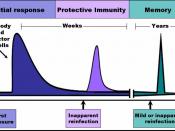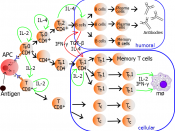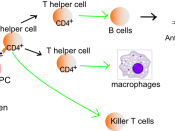Mammalian blood possesses a number of defensive functions |
Skin is composed of dead cells containing the indigestible protein keratin Sebum produced by the skin lowers the pH to inhibit growth of pathogens Lysozymes in salvia, sweat and tears are anti-bacterial enzymes Many ingested bacteria in the stomach are destroyed by acid (HCl) A sticky substance, mucus, traps pathogens in the respiratory tract Cilia moves away mucus towards the throat to protect gas exchange surfaces The immune system targets foreign materials and pathogens |
Inflammatory response |
Histamine is released into the wound by white cells This increases vasodilation and increases vascular permeability Vasodilation increases the local blood flow â area becomes red, warm Increased permeability allows escape of tissue fluid into the tissues Tissue fluid contains plasma proteins (antibodies) and may cause swelling |
Phagocytosis |
White cells (phagocytes) contain digestive enzymes within lysosomes Neutrophils primarily engulf bacteria Macrophages engulf larger particles; including old and infected red blood cells Found in blood, lymph systems and tissues Squeeze through gaps in the walls of venules to enter tissues This allows them to move faster to tissues infected with pathogens Phagocytes are attracted by chemotaxis Opsonisation by antibodies (bacteria becomes coated with antibody) As a result, binding between bacteria and phagocytes is improved Phagocytes form pseudopodia around the particle This positions the particle into a phagocytic vacuole (also called phagosome) Lysosome fuses with the phagosome Intracellular killing by digestive enzymes from the lysosome Pus if formed at the site of infection if no extensive vasculature is present |
Principle of immunology |
Antigen |
Molecule that stimulates an immune response Usually proteins (polysaccharides, nucleic acid, lipids can also act as antigens) and other inorganic molecules important for self-recognition Self-antigen Only found on the host's own cells and does not trigger an immune response As these are proteins, their structure... |



Allowed to a degree
Although i feel that euthanasia is a terrible answer to life's many problems, i feel it should still be allowed to an extent. I feel that it is only constitutional that one may dictate their own body and choose the outcome of their life, so long as they are not harming others. However, i feel that one may only make this decision if they are in complete control of there mental state. If there decision may be the influence of drugs or mantal illnesses, then i feel that this decision should not be up to them but up to those with a complete handle on the decision. Just though i would add my two sense :)
0 out of 0 people found this comment useful.